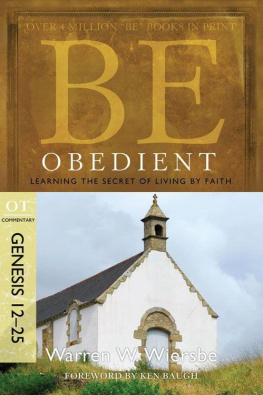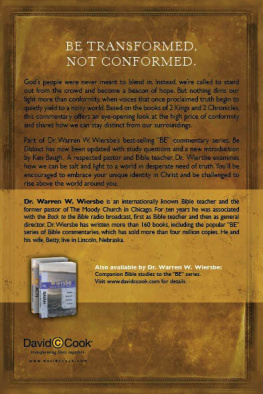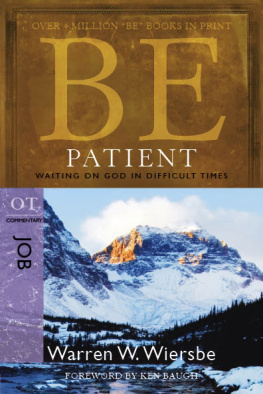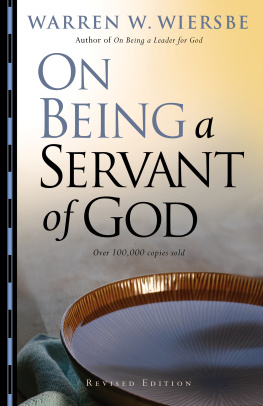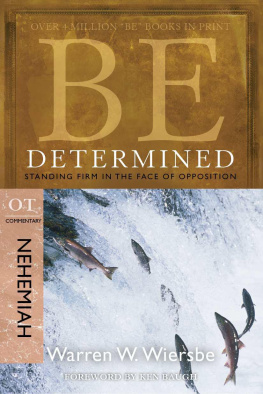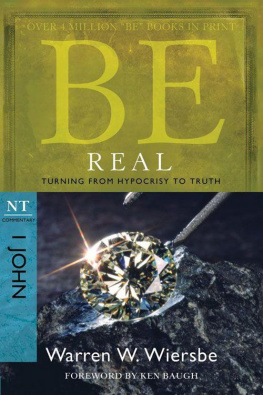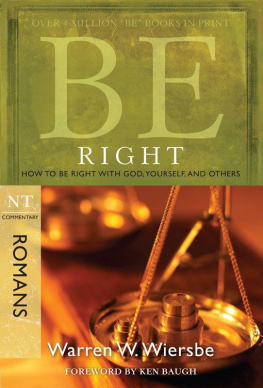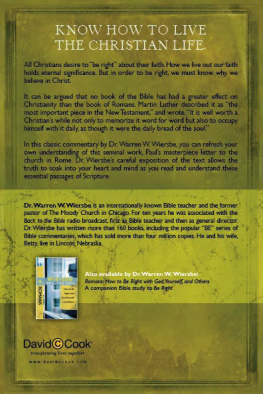
BE COMFORTED
Published by David C Cook
4050 Lee Vance View
Colorado Springs, CO 80918 U.S.A.
David C Cook Distribution Canada
55 Woodslee Avenue, Paris, Ontario, Canada N3L 3E5
David C Cook U.K., Kingsway Communications
Eastbourne, East Sussex BN23 6NT, England
The graphic circle C logo is a registered trademark of David C Cook.
All rights reserved. No part of this ebook may be reproduced, scanned, resold, or distributed by or through any print or electronic medium without written permission from the publisher. This ebook is licensed solely for the personal and noncommercial use of the original authorized purchaser, subject to the terms of use under which it was purchased. Please do not participate in or encourage piracy of copyrighted materials in violation of the authors rights.
Unless otherwise noted, Scripture quotations are taken from the King James Version of the
Bible. (Public Domain.) Scripture quotations marked NIV are taken from the Holy Bible,
New International Version . NIV . Copyright 1973, 1978, 1984 by International Bible
Society. Used by permission of Zondervan. All rights reserved; TLB are taken from The
Living Bible, 1971, Tyndale House Publishers, Wheaton, IL 60189. Used by permission;
NKJV are taken from the New King James Version. Copyright 1982 by Thomas
Nelson, Inc. Used by permission. All rights reserved; JB are excerpted from the Jerusalem
Bible , copyright 1966 by Darton, Longman & Todd Ltd. and Doubleday & Co., a
division of Bantam Doubleday Dell Publishing Group, Inc. Reprinted by permission.
LCCN 2009923009
ISBN 978-1-4347-6615-1
eISBN 978-0-7814-0098-5
1992 Warren W. Wiersbe
First edition of Be Comforted by Warren W. Wiersbe published by Victor Books
in 1992 Warren W. Wiersbe, ISBN 0-89693-797-6
The Team: Karen Lee-Thorp, Amy Kiechlin, Jack Campbell, and Susan Vannaman
Series Cover Design: John Hamilton Design
Cover Photo: Getty Images
Study Questions: Susan Moroney
Second Edition 2009
CONTENTS
: An Introduction to Be Comforted by Ken Baugh
1. (Introduction to Isaiah)
2. (Isaiah 16)
3. (Isaiah 712)
4. (Isaiah 1323)
5. (Isaiah 2427)
6. (Isaiah 2831)
7. (Isaiah 3235)
Interlude: (Isaiah 3639)
8. (Isaiah 3639)
Interlude: (Isaiah 4066)
9. (Isaiah 4048)
10. (Isaiah 49:152:12)
11. (Isaiah 52:1353:12)
12. (Isaiah 5459)
13. (Isaiah 6066)
The Big Idea
An Introduction to Be Comforted
by Ken Baugh
His name was Sir Ernest Henry Shackleton. His goal was to lead the first expedition across the South Polar continent known as Antarctica. However, before this expedition ended, Shackleton and his crew faced gale force winds over 150 miles per hour, bone-chilling temperatures of 100 degrees below zero, 80-foot seas, hunger, and the oppressively dark days of the Antarctic winter. In his book Endurance: Shackletons Incredible Voyage , Alfred Lansing describes this darkness:
In all the world there is no desolation more complete than the polar night. It is a return to the ice ageno warmth, no life, no movement. Only those who have experienced it can appreciate what it means to be without the sun day after day and week after week. Few men unaccustomed to it can fight off its effects altogether, and it has driven some men mad. (p. vii)
And yet in spite of these conditions, nothing could prepare Shackletons crew for the devastating destruction of their vessel, aptly named the Endurance . The Endurance became trapped in the icy Weddell Sea and forced the crew to survive through extreme conditions for an entire Antarctic winter. However, once the spring thaw began, instead of being released from its frozen prison, the ship was crushed by large blocks of floating ice. These damaged the hull beyond repair and left the entire expedition stranded.
Mounting all the courage and strength they could muster, the men loaded into the three remaining lifeboats and began rowing toward Elephant Island, 100 miles away. By the time they reached the island, it was the first time in 497 days that they had stood on solid ground. But their ordeal was not over yet. Elephant Island was outside the main shipping channels, and nobody knew they were there, so they had no hope of rescue. Their only chance for survival was to add a makeshift sail to one of the lifeboats and attempt to sail from Elephant Island to the South Georgia Whaling station.
There was only one small problem with this: South Georgia was 800 miles away! Resolved to save his men, Captain Shackleton chose four others and set sail for South Georgia on April 24, promising those he was leaving behind that he would come back for them. Miraculously, on May 9, they sighted South Georgia, but the winds made a landing impossible, so they waited until morning. During the night, a full-blown hurricane hit, and they thought it was the end. But again, by some miracle they survived the night drifting in their lifeboat and landed on the unoccupied southern shore of South Georgia the next morning. Fearing that putting out to sea again to reach the whaling station would be too dangerous, Shackleton made a land crossing by foot that had never been attempted before. It took him and two of the other men thirty-six hours to reach the whaling station at Stromness.
Without delay, he assembled a rescue party to get the men he had left behind on Elephant Island, but his first three attempts failed due to rough seas and bad weather. Finally, he secured a small tugboat from the Chilean Navy and rescued all twenty-two of his stranded men. Shackleton had kept his promise to return. Wow! What an incredible story of courage and devotion. Shackleton loved his men so much that he risked his life numerous times to save them.
The trials surrounding this event in the life of Sir Ernest Shackleton remind me of the Big Idea that runs throughout the book of Isaiah, namely that the Lord saves. According to Isaiah, Jesus is the Savior who is coming, the Savior who came, and the Savior who is coming back one day. Lets take a look at these three dynamics in regard to our God who saves in the book of Isaiah.
First, Isaiah said that a Savior was coming (predicted in Isaiah 7:14; 9:67; fulfilled in Matthew 1:1825). He said this Savior would come through the line of Jesse, the father of King David (predicted in Isaiah 11:1; fulfilled in Luke 3:23, 32). Isaiah recorded these prophecies seven hundred years before Jesus was born. Jesus Christ is the Messiah, our Savior whom Isaiah said would come.
Second, Isaiah said what would happen to the Savior once He came. The Savior would perform miracles (predicted in Isaiah 35:56; fulfilled in Matthew 9:35). He would be rejected by His own people (predicted in Isaiah 53:3; fulfilled in John 7:5, 48). He would stand silent before His accusers (predicted in Isaiah 53:7; fulfilled in Matthew 27:12). He would be wounded and bruised (predicted in Isaiah 53:5; fulfilled in Matthew 27:26), smitten and spit upon (predicted in Isaiah 50:6; fulfilled in Matthew 26:67). He would pray for His persecutors (predicted in Isaiah 53:12; fulfilled in Luke 23:34). He would be crucified with two thieves (predicted in Isaiah 53:9; fulfilled in Matthew 27:38). He would be buried in a rich mans tomb (predicted in Isaiah 53:9; fulfilled in Matthew 27:5760). Again, Jesus was the One who fulfilled all of these prophecies, and He did so to pay the price for my sin and yours, so that through faith in Him, we might gain forgiveness and eternal life. Jesus Christ is the Messiah, our Savior who Isaiah said would come to suffer and die in our place.
Next page


